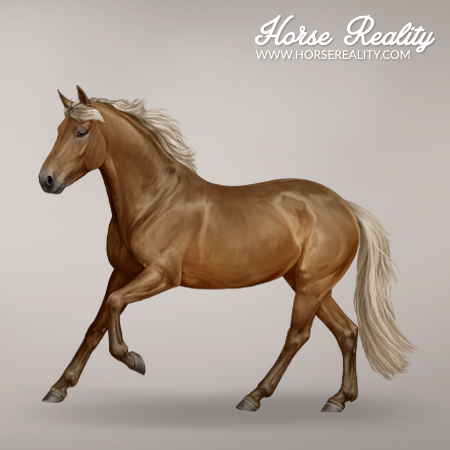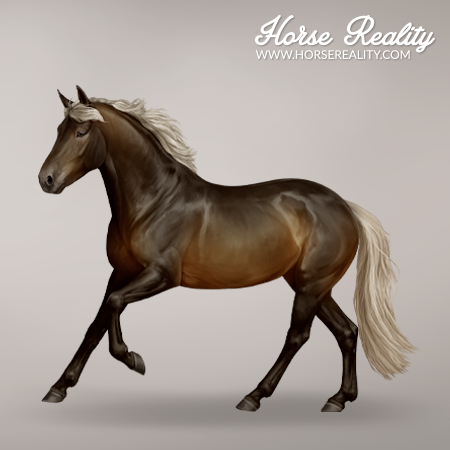Silver, also known as taffy (Australia), silver dapple or “chocolate”, is one of the dilutions present in horses.
¶ Phenotype
Silver only affects black pigment, and therefore doesn't show on chestnut-based horses. Chestnut horses may however still carry silver and pass it on to their offspring, which could lead to some surprises!
Silver mainly dilutes the long hairs (mane, tail and feathering) of black and bay-based horses to a nearly white colour. The body is usually not or only slightly diluted. Silver horses may have light, nearly white eyelashes and coarse muzzle and facial hairs, but this rule also has its exceptions. Horses with the silver dilution may have pronounced dappling, rings of lighter colour, on their coat. The eyes and skin are both dark. Foals are often very pale at birth, and then darken as they age. This may make adult silver horses harder to recognise, as the mane and tail can sometimes darken dramatically. Foals may also be born with striped hooves, but these will also fade over time as the hooves grow.
| Silver - Finnhorse | |
| Example | Information |
|

|
Silver bay (bay + silver) Silver on a bay base creates horses with a light mane and tail. They usually have lighter points, which may appear dark brown. Silver bay horses bay may look similar to flaxen chestnut horses. However, silver horses can usually be identified by looking at their black points.
|

|
Silver seal brown (seal brown + silver) Silver seal brown produces a horse with a light mane and tail. Since more black pigment is present on the coat, silver seal brown horses may have a slightly diluted body, similar to silver black horses. |

|
Silver black (black + silver) Silver black is possibly the most well-known coat with this dilution. It causes a black coat with a light mane and tail. The coat may get diluted to a more grey-brown colour and dapples are very common. |
¶ Genotype
The silver (Z) dilution is caused by a mutation in the PMEL17 gene and is a dominant dilution. Both heterozygous and homozygous horses have the same phenotype. Below, the resulting phenotype of each genotype is listed:
- Z/Z = Silver
- Z/z = Silver
- z/z = Not silver
Silver can be tested at the Laboratory.
In real life, studies have shown that the silver allele is associated with ocular (eye) defects. Horses that are homozygous are more likely to have more severe MCOA (Multiple Congenital Ocular Abnormalities syndrome) disorder; which includes cysts, additional eye abnormalities, and possibly impaired vision. Horses heterozygous for silver are more likely to have cysts only with (nearly) normal vision. Even though the colour of chestnut horses is not affected by silver, they can still have these ocular problems. However, in Horse Reality silver horses do not have any additional health defects due to the dilution.
¶ Breeds
Silver is a popular colour in many gaited breeds, the most well-known one being the Rocky Mountain Horse, which has silver as its signature colour. The dilution is also present in several pony and draft breeds and in some warmbloods; more commonly in breeds of European descent. The following table lists all breeds that can currently have the silver (Z) allele in-game.
| Breeds |
| Akhal-Teke Horse |
| Arabian Horse |
| Brabant Horse |
| Brumby Horse |
| Camargue Horse |
| Cleveland Bay |
| Exmoor Horse |
| Finnhorse |
| Fjord Horse |
| Friesian Horse |
| Haflinger Horse |
| Icelandic Horse |
| Irish Cob Horse |
| Kladruber Horse |
| Knabstrupper |
| Lipizzaner |
| Lusitano |
| Mongolian Horse |
| Mustang Horse |
| Namib Desert Horse |
| Noriker Horse |
| Norman Cob |
| Oldenburg Horse |
| Pantaneiro Horse |
| Pura Raza Española |
| Quarter Horse |
| Shetland Pony |
| Shire Horse |
| Suffolk Punch |
| Thoroughbred |
| Trakehner Horse |
| Welsh Pony |
¶ References
- Bellone R., Sponenberg D. P., Equine Color Genetics, 4th Edition, 2017, Wiley-Blackwell
- UC Davis Veterinary Genetics Laboratory; https://vgl.ucdavis.edu/test/silver ; Access: November 2022
- Generatio Center for Animal Genetics; https://generatio.de/en/guidance/lexicon/silver-dapple-dilution-factor-horse; Access: November 2022